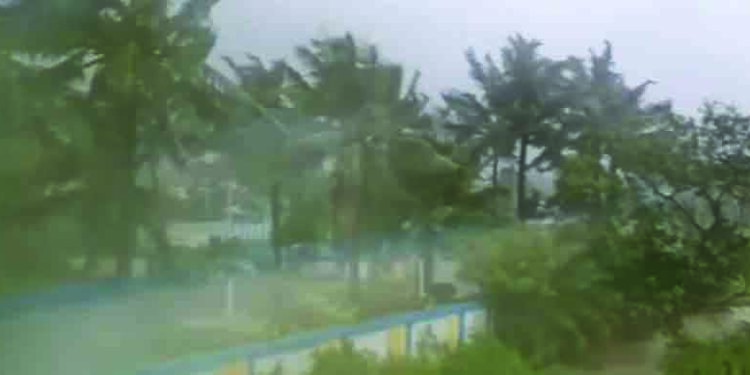NE NEWS SERVICE
NEW DELHI, MAY 20
The Bay of Bengal’s fiercest storm this century, cyclone Amphan, slammed into the coast of West Bengal, Odisha in India and Bangladesh on Wednesday afternoon, bringing heavy wind and the threat of deadly storm surges and flooding.
The intensity of the cyclone as it made landfall at 4 pm local time was around 120 mph, with waves 5 metres high from the sea level, before it moved northwards towards Kolkata. The first deaths from the cyclone, one in Bangladesh and two in West Bengal, were reported on Wednesday afternoon.
#CycloneAmphan Updates 20/5/20-
𝐃𝐀𝐘 𝟎@NDRFHQ @ Awareness Work in Namkhana, South 24 Parganas, West Bengal#WithPeople #NDRF4U#Committed2Serve #LetsFaceAmphanTogether @NDRFHQ @ndmaindia @PMOIndia @HMOIndia @PIBHomeAffairs @BhallaAjay26 @DDNewslive @ANI @airnewsalerts pic.twitter.com/6FlhacKfkm
— ѕαtчα prαdhαnसत्य नारायण प्रधान ସତ୍ୟ ପ୍ରଧାନ (@satyaprad1) May 20, 2020
In Bangladesh, more than 2 million people were evacuated, and a further half a million people in the Indian states of West Bengal and Odisha were moved from vulnerable low-lying areas to shelters. The Indian navy was put on high alert to be ready to offer humanitarian assistance to those caught up in Cyclone Amphan, which is only the second “super-cyclone” to form in the Bay of Bengal since records began.
The Director General of the National Disaster Response Force (NDRF), SN Pradhan, said the situation was “fast-transforming” as the cyclone moved across West Bengal and Odisha.
“It is another form of new normal, we have to handle disasters considering the pandemic too. In view of the prevailing Covid-19 scenario, all teams are equipped with PPE,” said Pradhan.
Evacuation efforts had been hampered by the need to follow strict physical distancing precautions to prevent the spread of coronavirus, with infection numbers still soaring in both countries. Many people had also refused to leave their homes and be moved to shelters for fear of contracting the virus.
India and Bangladesh government’s said they were using extra shelter space to reduce crowding, while also making face masks compulsory and providing extra soap and sanitiser.
“Earlier we had around 5,000 cyclone centres and this time we will have more than 12,000: this is how we will maintain social distancing in the shelters,” said Enamur Rahman, Bangladesh’s junior disaster management minister. “We are also keeping separate isolation rooms in the shelters for any infected patients.”
The Catholic Relief Services (CRS) aid group said people faced “an impossible choice” of braving the cyclone by staying put, or risking coronavirus infection in a shelter.
In the Cox’s Bazar refugee camps in Bangladesh, hundreds of Rohingya were moved from Bhasan Char, a flood-prone island in the Bay of Bengal where the government has controversially begun to house some of the refugees.
There are also fears the storm will do large-scale damage to the Sundarbans forest reserve, a UNESCO world heritage site across the India and Bangladesh border, which is home to 96 protected tigers and other endangered species.
The Indian weather department forecast a storm surge of 10-foot to 16-foot waves that could swamp mud dwellings along the coast, uproot communication towers and inundate roads and railway lines.
Storm surges can force a wall of water to cascade several kilometres inland, and are often responsible for massive loss of life during the most severe cyclones.
Bangladesh’s low-lying coast, home to 30 million people, and India’s east are regularly battered by cyclones that have killed hundreds of thousands of people in recent decades.
In 1999, the eastern state of Odisha was hit by a super-cyclone that killed nearly 10,000 people. Eight years earlier, a typhoon, tornadoes and flooding killed 139,000 in Bangladesh.
Bangladesh authorities fear Amphan will be the most powerful storm since Cyclone Sidr devastated the country in 2007, killing about 3,500 people and causing billions of pounds in damage.
Although outside the predicted direct path of the storm, there are fears for the safety of almost a million Rohingya refugees from Myanmar in south-eastern Bangladesh – most living in vast camps and housed in flimsy makeshift shacks.
The first coronavirus cases were reported there last week, and by Tuesday there were six confirmed infections.
The UN said emergency items such as food, tarpaulins and water purification tablets had been stockpiled, while authorities said the refugees would be moved to sturdier buildings such as schools.










